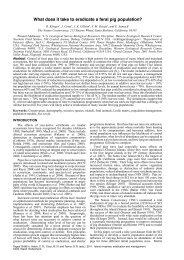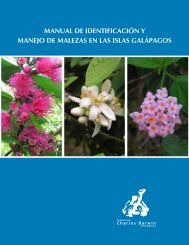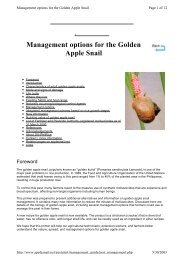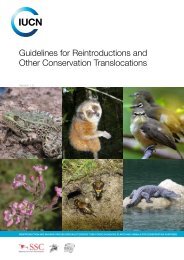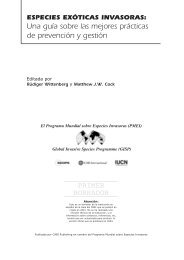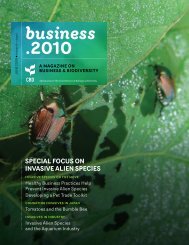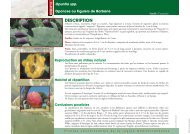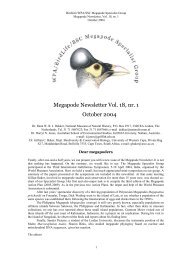Introduced land snails in the Fiji Islands - IUCN Invasive Species ...
Introduced land snails in the Fiji Islands - IUCN Invasive Species ...
Introduced land snails in the Fiji Islands - IUCN Invasive Species ...
Create successful ePaper yourself
Turn your PDF publications into a flip-book with our unique Google optimized e-Paper software.
Is<strong>land</strong> <strong>in</strong>vasives: eradication and management<br />
Brodie, G. and G.M. Barker. <strong>Introduced</strong> <strong>land</strong> <strong>snails</strong> <strong>in</strong> <strong>the</strong> <strong>Fiji</strong> Is<strong>land</strong>s: are <strong>the</strong>re risks <strong>in</strong>volved?<br />
<strong>Introduced</strong> <strong>land</strong> <strong>snails</strong> <strong>in</strong> <strong>the</strong> <strong>Fiji</strong> Is<strong>land</strong>s: are <strong>the</strong>re risks <strong>in</strong>volved?<br />
G. Brodie 1 and G. M. Barker 2<br />
1<br />
Biology Division, FSTE, University of <strong>the</strong> South Pacific, Private Bag, Suva, <strong>Fiji</strong> Is<strong>land</strong>s. .<br />
2<br />
Landcare Research, Hamilton, New Zea<strong>land</strong>.<br />
Abstract <strong>Fiji</strong>’s <strong>land</strong> snail fauna is highly diverse. There are over 230 species of which about 90% are native and 78%<br />
are endemic to <strong>the</strong> archipelago. There are 18 <strong>in</strong>troduced species and four that are of uncerta<strong>in</strong> orig<strong>in</strong> with<strong>in</strong> <strong>the</strong> Pacific.<br />
Information to allow easy identification of <strong>the</strong>se species is lack<strong>in</strong>g, as is related <strong>in</strong>formation about <strong>the</strong> risks <strong>in</strong>volved<br />
with <strong>the</strong> <strong>in</strong>troduced species <strong>in</strong> respect to trade, crop production or human and livestock health. To address this latter<br />
<strong>in</strong>formation gap, exist<strong>in</strong>g and new data on <strong>Fiji</strong>’s <strong>in</strong>troduced <strong>land</strong> snail fauna were collated. This <strong>in</strong>formation is urgently<br />
required to identify and manage <strong>in</strong>troduced and potentially <strong>in</strong>vasive species and if possible to prevent <strong>the</strong>ir spread to non<strong>in</strong>fected<br />
is<strong>land</strong>s. O<strong>the</strong>r Pacific Is<strong>land</strong> countries and territories have suffered substantial endemic <strong>land</strong> snail biodiversity<br />
loss, particularly because of <strong>in</strong>vasive snail species that are not yet present <strong>in</strong> <strong>Fiji</strong>. Except for one of <strong>the</strong>se latter species, <strong>the</strong><br />
giant African snail (Achat<strong>in</strong>a (Lissachat<strong>in</strong>a) fulica), <strong>the</strong> <strong>Fiji</strong> government authorities have no basel<strong>in</strong>e reference material<br />
that allows <strong>the</strong>m to quickly and accurately identify and understand <strong>the</strong> biology of even <strong>the</strong> most common <strong>in</strong>troduced<br />
<strong>snails</strong>. If not addressed this lack of <strong>in</strong>formation may have major long-term implications for agriculture, quarant<strong>in</strong>e, trade<br />
and human health. The alien species already <strong>in</strong>troduced to <strong>Fiji</strong> are spread<strong>in</strong>g unacknowledged despite several of <strong>the</strong>m<br />
be<strong>in</strong>g known disease vectors and agricultural pests elsewhere. This paper provides collated <strong>land</strong> snail <strong>in</strong>formation to<br />
government departments such as agriculture, quarant<strong>in</strong>e, forestry and environment, and <strong>in</strong> turn provides a platform on<br />
which to build a stronger understand<strong>in</strong>g of how <strong>in</strong>troduced snail species may be impact<strong>in</strong>g trade, agricultural production<br />
and human and livestock health <strong>in</strong> <strong>Fiji</strong>.<br />
Keywords: Mollusc, gastropod, slug, Pacific Is<strong>land</strong>s, Parmarion martensi, <strong>in</strong>vasive<br />
INTRODUCTION<br />
The <strong>land</strong> snail fauna of <strong>the</strong> south Pacific is<strong>land</strong>s of <strong>Fiji</strong> is<br />
unique and highly diverse. Over 230 species are recorded,<br />
of which 22 are non-native. About 90% of <strong>the</strong> fauna is<br />
native and 78% are endemic to <strong>the</strong> archipelago (Barker<br />
et al. 2005). Information to allow easy identification of<br />
species is lack<strong>in</strong>g, as is collated <strong>in</strong>formation about <strong>the</strong> risks<br />
non-native species pose to trade, crop production or human<br />
and livestock health (Brodie 2009a). Many of <strong>the</strong> nonnative<br />
species are known agricultural pests and parasite<br />
vectors elsewhere <strong>in</strong> <strong>the</strong> world. Collated <strong>in</strong>formation is<br />
urgently required to detect and adequately manage nonnative<br />
species, and if possible to prevent <strong>the</strong> spread of<br />
<strong>in</strong>vasive species to non-<strong>in</strong>fected is<strong>land</strong>s.<br />
Pacific Is<strong>land</strong> countries and territories such as Samoa,<br />
New Caledonia, French Polynesia and Hawaii (Fig. 1)<br />
have lost much of <strong>the</strong>ir endemic <strong>land</strong> snail biodiversity<br />
(Bouchet and Abdou 2003; Brescia et al. 2008; Cowie and<br />
Rob<strong>in</strong>son 2003; Hadfield 1986), <strong>in</strong> some cases follow<strong>in</strong>g<br />
<strong>the</strong> <strong>in</strong>troduction of <strong>in</strong>vasive snail species that are not yet<br />
established <strong>in</strong> <strong>Fiji</strong>. Two such examples are <strong>the</strong> “rosy<br />
wolf snail” (Eug<strong>land</strong><strong>in</strong>a rosea) and <strong>the</strong> giant African<br />
snail (Achat<strong>in</strong>a (Lissachat<strong>in</strong>a) fulica). Except for <strong>the</strong><br />
latter species, <strong>Fiji</strong>an government agencies have very little<br />
basel<strong>in</strong>e reference material that allows quick and accurate<br />
identification of <strong>snails</strong>. This even applies to <strong>the</strong> most<br />
common <strong>in</strong>troduced terrestrial <strong>snails</strong> located close to <strong>the</strong><br />
well established port area of <strong>the</strong> capital Suva, on <strong>the</strong> largest<br />
is<strong>land</strong>, Viti Levu (Fig. 2). <strong>Fiji</strong>an government agencies also<br />
have relatively little collated biological <strong>in</strong>formation which<br />
could be used to make management decisions or implement<br />
monitor<strong>in</strong>g programmes <strong>in</strong> relation to any of <strong>the</strong> currently<br />
<strong>in</strong>troduced <strong>land</strong> snail species. If not addressed this lack of<br />
<strong>in</strong>formation may have major long-term implications for<br />
agriculture, quarant<strong>in</strong>e, <strong>in</strong>ternational trade, and livestock<br />
and human health <strong>in</strong> <strong>Fiji</strong>.<br />
This current paper is part of a larger plan by <strong>the</strong> authors<br />
to provide direct <strong>land</strong> snail identification assistance<br />
to sectors of <strong>the</strong> <strong>Fiji</strong> government such as agriculture,<br />
quarant<strong>in</strong>e, forestry and environment, and to improve<br />
understand<strong>in</strong>g of how <strong>in</strong>troduced <strong>land</strong> snail species may<br />
impact biodiversity, economic costs and human health <strong>in</strong><br />
<strong>the</strong> <strong>Fiji</strong> Is<strong>land</strong>s. In turn, collation of this <strong>in</strong>formation will<br />
also allow estimates of <strong>the</strong> potential impact of <strong>the</strong>se alien<br />
<strong>in</strong>truders on <strong>Fiji</strong>’s established trad<strong>in</strong>g partners. In addition,<br />
<strong>the</strong> current paper addresses a broader acknowledged<br />
Fig. 1 <strong>Fiji</strong>’s location <strong>in</strong> <strong>the</strong> Pacific show<strong>in</strong>g neighbour<strong>in</strong>g<br />
is<strong>land</strong>s.<br />
Fig. 2 The <strong>Fiji</strong> Is<strong>land</strong>s show<strong>in</strong>g <strong>the</strong> location of <strong>the</strong> capital<br />
city Suva and <strong>the</strong> is<strong>land</strong>s of Viti Levu, Taveuni and Rotuma.<br />
The Lau Group <strong>in</strong>cludes all of <strong>the</strong> small is<strong>land</strong>s <strong>in</strong> <strong>the</strong><br />
sou<strong>the</strong>ast of <strong>the</strong> archipelago.<br />
Pages 32 32-36 In: Veitch, C. R.; Clout, M. N. and Towns, D. R. (eds.). 2011. Is<strong>land</strong> <strong>in</strong>vasives: eradication and management.<br />
<strong>IUCN</strong>, G<strong>land</strong>, Switzer<strong>land</strong>.
Brodie & Barker: <strong>Introduced</strong> <strong>land</strong> <strong>snails</strong> <strong>Fiji</strong>, <strong>the</strong> risks<br />
need to fill major <strong>in</strong>formation gaps on <strong>the</strong> distribution of<br />
<strong>in</strong>troduced <strong>land</strong> <strong>snails</strong> <strong>in</strong> <strong>the</strong> Pacific Is<strong>land</strong>s region (Sherley<br />
2000).<br />
MATERIALS AND METHODS<br />
We compiled a checklist of <strong>land</strong> <strong>snails</strong> <strong>in</strong>troduced to<br />
<strong>Fiji</strong> us<strong>in</strong>g <strong>the</strong> results of surveys <strong>in</strong> many forest areas and<br />
villages throughout <strong>the</strong> archipelago to 2005 (Barker et al.<br />
2005; Barker, unpublished data) and <strong>in</strong> 2008 - 2010 on<br />
Viti Levu (Brodie 2009b; Brodie and Cope<strong>land</strong> <strong>in</strong> press;<br />
Mila et al. 2010) and Taveuni (Brodie unpublished data).<br />
By comb<strong>in</strong><strong>in</strong>g <strong>the</strong> above results with our expert knowledge<br />
and additional published reports on aspects of distribution,<br />
biology, ecology, and “pest” status, we added to our<br />
checklist an estimated risk level for each species. Risk<br />
level was identified as low, medium or high depend<strong>in</strong>g on<br />
our estimate of <strong>the</strong>ir potential to <strong>in</strong>flict biodiversity loss,<br />
affect agricultural production, and/or impact on human or<br />
livestock health <strong>in</strong> <strong>Fiji</strong>.<br />
The term ‘<strong>land</strong> snail’ as a common name is used <strong>in</strong><br />
preference to dist<strong>in</strong>guish<strong>in</strong>g ‘<strong>snails</strong>’ and ‘slugs’.<br />
RESULTS<br />
Eighteen species of <strong>in</strong>troduced <strong>land</strong> <strong>snails</strong> from n<strong>in</strong>e<br />
families are currently known from <strong>the</strong> <strong>Fiji</strong> Is<strong>land</strong>s (Table 1).<br />
This total excludes <strong>the</strong> widespread Pacific Achat<strong>in</strong>ellidae<br />
Elasmias apertum, Lamellidea pusilla, Lamellidea oblonga<br />
and Helicarionidae Liardetia samoensis for which precise<br />
orig<strong>in</strong>s with<strong>in</strong> <strong>the</strong> Pacific are uncerta<strong>in</strong>.<br />
The feed<strong>in</strong>g types and diets of <strong>the</strong> <strong>in</strong>troduced species<br />
range from herbivores on fresh plant material, detritivores<br />
feed<strong>in</strong>g on dead plant material, to carnivorous predators<br />
(Table 1). Our data suggest that <strong>the</strong> <strong>in</strong>troduced Streptostele<br />
musaecola, Bradybaena similaris, and Deroceras laeve<br />
are restricted to areas of human habitation or disturbance.<br />
The rema<strong>in</strong><strong>in</strong>g species are found <strong>in</strong> both disturbed and<br />
relatively undisturbed habitats and must be considered<br />
“<strong>in</strong>vasive”. Of <strong>the</strong>se, n<strong>in</strong>e species are considered here as<br />
low risk, three low-medium risk and five medium-high<br />
risk (Table 2). One species, Parmarion martensi (Fig. 3),<br />
stands out as very high risk and very <strong>in</strong>vasive because of its<br />
hardy nature, active climb<strong>in</strong>g behaviour, close association<br />
with local crops and common presence <strong>in</strong> virtually all<br />
sheltered habitats <strong>in</strong>vestigated, <strong>in</strong>clud<strong>in</strong>g <strong>the</strong> significant<br />
forest conservation areas of Nakauvadra, Nakorotubu<br />
and Taveuni. While <strong>the</strong> presence of P. martensi is longknown<br />
from <strong>Fiji</strong>’s low<strong>land</strong> to mid-altitude areas, recent<br />
surveys by <strong>the</strong> first author <strong>in</strong>dicate <strong>in</strong>vasion <strong>in</strong>to relatively<br />
undisturbed high altitude areas (i.e., Taveuni, > 800 m) that<br />
are vitally important for overall ecosystem function and <strong>the</strong><br />
conservation of endemic biodiversity.<br />
Fig. 3 Parmarion martensi on decay<strong>in</strong>g pumpk<strong>in</strong> <strong>in</strong> a<br />
suburban Suva garden. Photo: G. Brodie.<br />
DISCUSSION<br />
Although many papers have been published about <strong>land</strong><br />
<strong>snails</strong> <strong>in</strong> <strong>Fiji</strong> over <strong>the</strong> last 100 years (see review of Barker et<br />
al. 2005), this is <strong>the</strong> first to focus on non-native species <strong>in</strong><br />
<strong>the</strong> archipelago. The 18 species listed here <strong>in</strong>clude several<br />
of <strong>the</strong> expected widespread tropical “tramp” species that<br />
are thought to be replac<strong>in</strong>g Pacific Is<strong>land</strong> native/endemic<br />
mollusc fauna (Cowie 2004). There is also considerable<br />
overlap with <strong>the</strong> <strong>in</strong>troduced <strong>land</strong> snail assemblage reported<br />
by Cowie (2001) and Cowie and Rob<strong>in</strong>son (2003) <strong>in</strong> <strong>the</strong><br />
neighbour<strong>in</strong>g Samoan Is<strong>land</strong>s, but a much lower number of<br />
<strong>in</strong>troduced species than <strong>the</strong> more than 53 species recorded<br />
<strong>in</strong> Hawaii (Cowie 1998; Cowie et al. 2008).<br />
Unlike <strong>the</strong> neighbour<strong>in</strong>g is<strong>land</strong>s of New Caledonia,<br />
Vanuatu and Samoa, but like Tonga, Niue and <strong>the</strong> Cook<br />
Is<strong>land</strong>s, <strong>Fiji</strong> lacks two of <strong>the</strong> world’s worst <strong>in</strong>vasive<br />
<strong>land</strong> snail species: Achat<strong>in</strong>a (Lissachat<strong>in</strong>a) fulica and<br />
Eug<strong>land</strong><strong>in</strong>a rosea. Achat<strong>in</strong>a fulica is a direct economic<br />
threat to agricultural production and human and livestock<br />
health (Boray 1998; Lowe et al. 2004; Raut and Barker<br />
2002), while E. rosea poses severe ecological threat by its<br />
potential voracious predation on native <strong>land</strong> <strong>snails</strong> (Cowie<br />
2001, 2004; Lowe et al. 2004).<br />
The risks posed by <strong>the</strong>se two <strong>in</strong>vasive species to <strong>Fiji</strong><br />
emphasize <strong>the</strong> need for biosecurity measures to conserve<br />
<strong>the</strong> country’s dist<strong>in</strong>ctive and diverse endemic <strong>land</strong> snail<br />
fauna. Lydeard et al. (2004) highlighted <strong>the</strong> global and<br />
regional importance of Pacific Is<strong>land</strong> <strong>land</strong> snail fauna,<br />
while Sherley (2000) stressed that “prevention of entry,<br />
ra<strong>the</strong>r than later control, is <strong>the</strong> most important means of<br />
stopp<strong>in</strong>g <strong>the</strong> spread [and <strong>the</strong>refore effect] of pest <strong>snails</strong>”.<br />
In a <strong>Fiji</strong>an context, discussion of <strong>the</strong> exceptional need<br />
for high-level quarant<strong>in</strong>e vigilance is timely, primarily<br />
because of <strong>the</strong> recent nom<strong>in</strong>ation of <strong>the</strong> is<strong>land</strong> of Rotuma<br />
(Fig. 2 <strong>in</strong>set) as a “Port of Entry” for <strong>Fiji</strong>an shipp<strong>in</strong>g and<br />
trade, but especially agricultural crops. Like many remote<br />
is<strong>land</strong>s <strong>in</strong> <strong>the</strong> <strong>Fiji</strong>an archipelago, Rotuma has a dist<strong>in</strong>ctive<br />
<strong>land</strong> snail fauna (Barker et al. 2005; Brodie et al. 2010). To<br />
<strong>the</strong> best of our knowledge, no recent survey of <strong>in</strong>troduced<br />
<strong>land</strong> <strong>snails</strong> has been undertaken ei<strong>the</strong>r <strong>in</strong> Rotuma or its<br />
<strong>in</strong>tended primarily agricultural trad<strong>in</strong>g partner, Tuvalu. In<br />
this context <strong>the</strong> presence or absence of high-risk Parmarion<br />
martensi <strong>in</strong> Rotuma and/or Tuvalu is of great <strong>in</strong>terest, not<br />
only because of human health concerns and <strong>the</strong> <strong>in</strong>vasive<br />
nature of P. martensi <strong>in</strong> o<strong>the</strong>r parts of <strong>Fiji</strong>, but because <strong>the</strong><br />
species is also not yet recorded <strong>in</strong> several countries with<br />
which <strong>Fiji</strong> currently trades, such as Australia, New Zea<strong>land</strong><br />
and <strong>the</strong> ma<strong>in</strong><strong>land</strong> USA.<br />
Our report<strong>in</strong>g of P. martensi from at least three of <strong>the</strong><br />
13 priority forest conservation areas identified on <strong>the</strong> <strong>Fiji</strong>an<br />
is<strong>land</strong>s of Viti Levu and Taveuni (see Olson et al. 2009)<br />
makes protection of <strong>the</strong> smaller, more isolated, priority<br />
conservation areas like Rotuma an even higher priority.<br />
At least seven of <strong>the</strong> <strong>in</strong>troduced <strong>land</strong> snail species found<br />
<strong>in</strong> <strong>Fiji</strong> act as vectors for parasitic helm<strong>in</strong><strong>the</strong>s (Table 2), such<br />
as <strong>the</strong> rat lung worm Angiostrongylus cantonensis, which is<br />
associated with eos<strong>in</strong>ophilic men<strong>in</strong>gitis <strong>in</strong> humans (Boray<br />
1998; Hollyer et al. 2010). Angiostrongylus cantonensis<br />
and eos<strong>in</strong>ophilic men<strong>in</strong>gitis are already established <strong>in</strong> <strong>Fiji</strong><br />
(Alicata 1962; Sano et al. 1987; Pa<strong>in</strong>e et al. 1994; Uchikawa<br />
et al. 1984). A recent study of Parmarion cf. martensi <strong>in</strong><br />
Hawaii (Holl<strong>in</strong>gsworth et al. 2007) identified its role <strong>in</strong><br />
spread<strong>in</strong>g A. cantonensis through an association with<br />
poorly washed home-grown crops, such as lettuce. The<br />
parasite has a high <strong>in</strong>fection rate and <strong>the</strong> vigorous climb<strong>in</strong>g<br />
behaviour of P. martensi makes it much more likely to<br />
come <strong>in</strong>to contact with humans (and <strong>the</strong>ir food or water<br />
sources) than any of <strong>the</strong> o<strong>the</strong>r known vectors. However,<br />
<strong>the</strong> presence of A. cantonensis <strong>in</strong> <strong>Fiji</strong>an P. martensi has not<br />
yet been confirmed.<br />
33
Is<strong>land</strong> <strong>in</strong>vasives: eradication and management<br />
Table 1 List of <strong>Fiji</strong>’s <strong>in</strong>troduced <strong>land</strong> snail species with feed<strong>in</strong>g type and habitat.<br />
Feed<strong>in</strong>g ecology, secondary/m<strong>in</strong>or trophic relations <strong>in</strong>dicated <strong>in</strong> paren<strong>the</strong>ses.<br />
<strong>Species</strong> Feed<strong>in</strong>g ecology Habitat References<br />
Agriolimacidae<br />
Deroceras laeve<br />
Herbivore, detrit. High<strong>land</strong> <strong>in</strong>terior, <strong>in</strong> modified areas,<br />
(carnivore) <strong>in</strong>clud<strong>in</strong>g gardens, and forest marg<strong>in</strong>s.<br />
Ariophantidae<br />
Parmarion<br />
martensi<br />
Herbivore,<br />
detritivore<br />
Quantula striata Herbivore,<br />
Bradybaenidae<br />
Bradybaena<br />
similaris<br />
Pupillidae<br />
Gastrocopta<br />
pediculus<br />
Gastrocopta<br />
servilis<br />
Subul<strong>in</strong>idae<br />
Allopeas<br />
clavul<strong>in</strong>um<br />
Allopeas gracile<br />
Opeas hannense<br />
Opeas<br />
mauritianum<br />
Paropeas<br />
achat<strong>in</strong>aceum<br />
Subul<strong>in</strong>a octona<br />
Streptaxidae<br />
Gulella bicolor<br />
Streptostele<br />
musaecola<br />
Veronicellidae<br />
Laevicaulis alte<br />
Saras<strong>in</strong>ula<br />
plebeia<br />
Zonitidae<br />
Hawaiia<br />
m<strong>in</strong>uscula<br />
Valloniidae<br />
Ptychopatula<br />
orcula<br />
detritivore<br />
Herbivore,<br />
detritivore<br />
Detritivore<br />
Detritivore<br />
Detritivore<br />
(herbivore)<br />
Detritivore<br />
(herbivore)<br />
Detritivore<br />
(herbivore)<br />
Detritivore<br />
Detritivore<br />
(herb., carn.,<br />
predator)<br />
Detritivore<br />
(herbivore)<br />
Carnivorous<br />
predator<br />
Carnivorous<br />
predator<br />
Herbivore,<br />
detritivore<br />
Herbivore,<br />
detritivore<br />
Smith and Stanisic 1998; Barker 1999;<br />
Barker and Efford 2004<br />
Terrestrial, and arboreal on low vegetation.<br />
Low<strong>land</strong> to high-elevation forests.<br />
pers. obs., Holl<strong>in</strong>gsworth et al. 2007<br />
Leaf litter. Low<strong>land</strong> to mid-elevation forests;<br />
gardens.<br />
pers. obs., Councilman and Ong 1988.<br />
Terrestrial, arboreal on low veg. Low to<br />
high<strong>land</strong>s, disturbed areas, <strong>in</strong>cl. gardens.<br />
Pers. obs., Smith and Stanisic 1998;<br />
Chang 2002<br />
Under stones or logs, <strong>in</strong> leaf litter. Low<strong>land</strong>,<br />
<strong>in</strong> forests and modified areas.<br />
Smith and Stanisic 1998<br />
Under stones or logs, <strong>in</strong> leaf litter. Low<strong>land</strong><br />
forests.<br />
Smith and Stanisic 1998<br />
Leaf litter. Forests and disturbed areas, most<br />
prevalent <strong>in</strong> mid-elevation forests.<br />
Smith and Stanisic 1998<br />
Leaf litter. Low<strong>land</strong>s to high<strong>land</strong>s, <strong>in</strong> forest<br />
Smith and Stanisic 1998<br />
and modified habitats.<br />
Leaf litter. Low<strong>land</strong>s to mid-elevation forest<br />
and disturbed habitat.<br />
Barker et al. 2005<br />
Leaf litter. Low<strong>land</strong> to high-elevation forests<br />
and distributed area.<br />
Barker et al. 2005<br />
Leaf litter. Low<strong>land</strong> to mid-elevation forests<br />
and disturbed habitat.<br />
Naggs 1994; Barker and Efford 2004<br />
de Almeida Bessa and de Barros<br />
Under stones, logs and o<strong>the</strong>r debris. Leaf Araujo 1996; Smith and Stanisic 1998;<br />
litter. Low<strong>land</strong> to mid-elevations forests and d’Avila and de Almeida Bessa 2005;<br />
disturbed habitat<br />
Juřičková 2006; Holl<strong>in</strong>gsworth et al.<br />
2007.<br />
Under stones, logs and o<strong>the</strong>r debris. Leaf<br />
litter. Low<strong>land</strong>s, <strong>in</strong> forests and modified<br />
areas, <strong>in</strong>clud<strong>in</strong>g gardens.<br />
Leaf litter, under stones and logs. Low<strong>land</strong><br />
disturbed forests.<br />
Under stones, grass, decay<strong>in</strong>g wood, leaf<br />
litter & ground crevices. Low<strong>land</strong> to highelevation<br />
forests, plantations and moist tall<br />
grass<strong>land</strong>s.<br />
Under stones, grass, decay<strong>in</strong>g wood, leaf<br />
litter and ground crevices. Arboreal on<br />
low vegetation. Low<strong>land</strong> to mid-elevation<br />
forests, plantations, grass<strong>land</strong>s and gardens.<br />
Annandale and Prashad 1920; Dundee<br />
and Baerwald 1984; Naggs 1989;<br />
Smith and Stanisic 1998, Solem 1988;<br />
Barker and Efford 2004<br />
Smith and Stanisic 1998; Hausdorf<br />
and Med<strong>in</strong>a Bermúdez 2003<br />
pers. obs., Bishop 1977; Raut and<br />
Panigrahi 1990; Smith and Stanisic<br />
1998; Gomes and Thomé 2004<br />
pers. obs., Bishop 1977; Smith and<br />
Stanisic 1998; Rueda et al. 2002;<br />
Gomes and Thomé 2004<br />
Prob. carnivorous<br />
predator<br />
Leaf litter. Low<strong>land</strong>, disturbed areas. Kano 1996; Smith and Stanisic 1998<br />
Detritivore<br />
Arboreal, on tree trunks and branches.<br />
Low<strong>land</strong> forests.<br />
Solem 1964, 1988; Smith and Stanisic<br />
1998<br />
34
Brodie & Barker: <strong>Introduced</strong> <strong>land</strong> <strong>snails</strong> <strong>Fiji</strong>, <strong>the</strong> risks<br />
Table 2 Currently known status of <strong>in</strong>troduced <strong>land</strong> snail species considered to be present <strong>in</strong> <strong>the</strong> <strong>Fiji</strong> Is<strong>land</strong>s archipelago.<br />
<strong>Species</strong> Place of orig<strong>in</strong> Recorded pest/risk type<br />
Allopeas<br />
clavul<strong>in</strong>um<br />
Allopeas<br />
gracile<br />
Bradybaena<br />
similaris<br />
Deroceras<br />
laeve<br />
Gastrocopta<br />
pediculis<br />
Gastrocopta<br />
servilis<br />
Gullella<br />
bicolor<br />
Hawaiia<br />
m<strong>in</strong>uscula<br />
Laevicaulis<br />
alte<br />
Opeas<br />
hannense<br />
Opeas<br />
mauritianum<br />
Parmarion<br />
martensi<br />
Where risk<br />
recorded<br />
Estimate of<br />
risk <strong>in</strong> <strong>Fiji</strong><br />
Probably tropical<br />
East Africa<br />
No known threats n/a low<br />
Probably<br />
neotropics<br />
No known threats n/a low<br />
Asia<br />
Crop pest; vector of human<br />
and livestock parasites<br />
<strong>Fiji</strong>, Australia<br />
medium to<br />
high<br />
Holarcic and<br />
possibly Andean<br />
Crop pest; vector of human<br />
South America<br />
and livestock parasites<br />
Australia<br />
Indonesia.<br />
Probably western Status unknown could<br />
Pacific-Australian compete with native species n/a<br />
low<br />
area.<br />
West Indies<br />
Status unknown, could<br />
compete with native species n/a<br />
low<br />
Indian<br />
subcont<strong>in</strong>ent<br />
Predator of native fauna<br />
(micro predator on <strong>snails</strong>)<br />
Australia<br />
Canada to Status unknown, could prey<br />
nor<strong>the</strong>rn Mexico on native fauna<br />
n/a<br />
low<br />
Africa<br />
Crop pest; vector of human<br />
and livestock parasites<br />
Australia,<br />
Hawaii, Samoa high<br />
Tropical Central<br />
America<br />
Status unknown n/a low<br />
Unknown,<br />
probably India<br />
Status unknown n/a low<br />
low to<br />
medium<br />
medium to<br />
high<br />
medium to<br />
References<br />
Alicata 1965; Godan 1983<br />
Mackerras and Sandars 1955;<br />
Alicata 1965; Smith and<br />
Stanisic 1998<br />
Smith and Stanisic 1998<br />
Alicata 1965; Malek and<br />
Cheng 1974; Liat et al. 1965<br />
South-east Asia<br />
Vector of human and<br />
livestock parasites, crop pest Hawaii, Japan very high Holl<strong>in</strong>gsworth et al. 2007;<br />
Hollyer et al. 2010.<br />
Paropeas South-east Asia,<br />
Vector of human and<br />
achat<strong>in</strong>aceum Indonesia<br />
livestock parasites, competes<br />
Hawaii, Pacific low to<br />
with native species<br />
Is<strong>land</strong>s medium<br />
Alicata 1965, Cowie 2000.<br />
Ptychopatula<br />
India Status unknown n/a low<br />
orcula<br />
Quantula Sou<strong>the</strong>rn Malay Status unknown, may<br />
striata Pen<strong>in</strong>sula compete with native species n/a<br />
low<br />
Saras<strong>in</strong>ula<br />
Central America<br />
Crop pest; vector of human<br />
plebeia<br />
and livestock parasites<br />
Honduras<br />
medium to www.<strong>in</strong>vasive.org; Alicata<br />
high 1965; Rueda et al. 2002<br />
Streptostele<br />
West Africa<br />
Predator of native fauna<br />
musaecola<br />
(micro predator on <strong>snails</strong>)<br />
Australia<br />
medium to<br />
high<br />
Smith and Stanisic 1998<br />
Subul<strong>in</strong>a Caribbean and Crop pest; vector of human<br />
octona tropical America and livestock parasites<br />
Brazil, Hawaii<br />
low to<br />
de Almeida Bessa and<br />
medium<br />
de Barros Araujo 1996;<br />
Holl<strong>in</strong>gsworth et al. 2007<br />
CONCLUSION<br />
Increased collaborative effort is required to collate<br />
and dissem<strong>in</strong>ate available <strong>land</strong> snail <strong>in</strong>formation <strong>in</strong> a user<br />
friendly format. Improved access to such <strong>in</strong>formation will<br />
assist with basel<strong>in</strong>e surveys of isolated priority conservation<br />
areas. Although eradication of pest snail species may not<br />
be technically possible (Sherley 2000), prevent<strong>in</strong>g entry<br />
or halt<strong>in</strong>g <strong>the</strong> spread of high-risk pest <strong>snails</strong> <strong>in</strong>to some<br />
countries and is<strong>land</strong>s is more likely to be achieved when<br />
local awareness strategies are <strong>in</strong> place. For <strong>the</strong> high risk<br />
species such as Parmarion martensi, <strong>the</strong>se awareness<br />
strategies should <strong>in</strong>clude provision or re<strong>in</strong>forcement of <strong>the</strong><br />
need for preventative public health measures for both local<br />
communities and tourist facilities.<br />
ACKNOWLEDGEMENTS<br />
We acknowledge f<strong>in</strong>ancial support from <strong>the</strong> University<br />
of <strong>the</strong> South Pacific (FSTE LGS) and Conservational<br />
International (CEPF) plus logistical support from <strong>the</strong> South<br />
Pacific Regional Herbarium and <strong>the</strong> <strong>Fiji</strong> National Trust.<br />
We s<strong>in</strong>cerely thank <strong>the</strong> numerous colleagues that assisted<br />
with <strong>in</strong>troduced species field work, particularly Lekima<br />
Cope<strong>land</strong>, Richard S<strong>in</strong>gh, Elenoa Mila, Alisi Sheehy,<br />
Visheshni Chandra, Fiu Manueli and Johnson Seeto. Our<br />
s<strong>in</strong>cere thanks for constructive comments made to an<br />
earlier version of this manuscript by Robert Cowie, Fred<br />
Brook and Dick Veitch.<br />
REFERENCES<br />
Alicata, J.E. 1962. Observations on <strong>the</strong> occurrence of <strong>the</strong> rat-lungworm,<br />
Angiostrongylus cantonensis <strong>in</strong> New Caledonia and <strong>Fiji</strong>. The Journal of<br />
Parasitology 48: 595.<br />
Alicata, J.E. 1965. Biology and distribution of <strong>the</strong> rat lungworm,<br />
Angiostrongylus cantonensis, and its relationship to eos<strong>in</strong>ophilic<br />
men<strong>in</strong>goencephalitis and o<strong>the</strong>r neurological disorders of man and<br />
animals. Advances <strong>in</strong> Parasitology 3: 223-248.<br />
Annandale, N. and Prashad, B. 1920. Observations on <strong>the</strong> carnivorous<br />
<strong>land</strong>-snail (Ennea bicolor). Records of <strong>the</strong> Indian Museum 19: 189-<br />
194.<br />
35
Is<strong>land</strong> <strong>in</strong>vasives: eradication and management<br />
Barker, G.M. 1999. Naturalised terrestrial Stylommatophora (Mollusca:<br />
Gastropoda). Fauna of New Zea<strong>land</strong> No. 38. Manaaki Whenua Press,<br />
L<strong>in</strong>coln.<br />
Barker, G.M. and Efford, M. 2004. Predatory gastropods as natural<br />
enemies of terrestrial gastropods and o<strong>the</strong>r <strong>in</strong>vertebrates. Pp. 279-403.<br />
In: Barker, G.M. (ed.). Natural enemies of terrestrial molluscs. CABI<br />
Publish<strong>in</strong>g, Wall<strong>in</strong>gford, 644 pp.<br />
Barker, G.M.; Price, R. and Briggs, C. 2005. Priorities for additions to<br />
<strong>the</strong> <strong>Fiji</strong>an protected natural areas network: an assessment based on<br />
complementarity <strong>in</strong> <strong>land</strong> snail assemblages. New Zea<strong>land</strong> Landcare<br />
Research contract report prepared for Wildlife Conservation Society,<br />
Suva. 162 pp.<br />
Bishop, M.J. 1977. Terrestrial Mollusca of Queens<strong>land</strong>: <strong>the</strong> family<br />
Veronicellidae. Memoirs of <strong>the</strong> Queens<strong>land</strong> Museum 18: 53-59, pl. 18.<br />
Boray, J. 1998. Molluscs and parasitic diseases. Pp. 68-70. In: Beesley, P.;<br />
Ross, G. and Wells, A. (eds.). Mollusca: The Sou<strong>the</strong>rn Syn<strong>the</strong>sis. Fauna<br />
of Australia. Vol. 5. CSIRO Publish<strong>in</strong>g: Melbourne, Part A. 563 pp.<br />
Bouchet, P. and Abdou, A. 2003. Endemic <strong>land</strong> <strong>snails</strong> from <strong>the</strong> Pacific<br />
Is<strong>land</strong>s and <strong>the</strong> museum record: Document<strong>in</strong>g and dat<strong>in</strong>g <strong>the</strong> ext<strong>in</strong>ction<br />
of <strong>the</strong> terrestrial Assim<strong>in</strong>eidae of <strong>the</strong> Gambier Is<strong>land</strong>s. Journal of<br />
Molluscan Studies 69(3): 165-170.<br />
Brescia, F.; Pöllabauer, C.; Potter, M. and Robertson, A. 2008. A review<br />
of <strong>the</strong> ecology and conservation of Placostylus (Mollusca: Gastropoda:<br />
Bulimulidae) <strong>in</strong> New Caledonia. Molluscan Research 28(2): 111-122.<br />
Brodie, G. 2009a. Conservation of <strong>Fiji</strong>‘s <strong>land</strong> <strong>snails</strong>: biodiversity,<br />
agriculture and human health perspectives. In: Jenk<strong>in</strong>s, A.; Prasad, S.;<br />
Bacchiochi, J.; Skelton, P. and Yakub, N. (eds.). Proceed<strong>in</strong>gs of <strong>the</strong><br />
Inaugural <strong>Fiji</strong> Is<strong>land</strong>s Conservation Science Forum, Suva, <strong>Fiji</strong> Is<strong>land</strong>s,<br />
August 5-7th 2009.<br />
Brodie, G. 2009b. Prelim<strong>in</strong>ary observations of terrestrial gastropods of <strong>the</strong><br />
Nakauvadra Range, Ra Prov<strong>in</strong>ce, <strong>Fiji</strong>. Chapter 6. In: Morrison, C. and<br />
Nawadra, S. (eds.). A rapid biodiversity assessment of <strong>the</strong> Nakauvadra<br />
High<strong>land</strong>s, Ra Prov<strong>in</strong>ce, <strong>Fiji</strong>. RAP Bullet<strong>in</strong> of Biological Assessment<br />
57. Conservation International, Arl<strong>in</strong>gton, VA, USA.<br />
Brodie, G.; Barker, G.M.; Haynes, A. and S<strong>in</strong>gh, R. 2010. Land <strong>snails</strong><br />
of <strong>the</strong> <strong>Fiji</strong> Is<strong>land</strong>s: a summary of <strong>the</strong>ir biodiversity, quarant<strong>in</strong>e and<br />
agricultural status and human health relationships. Summary report<br />
to <strong>the</strong> <strong>Fiji</strong> Government Departments of Environment, Forestry and<br />
Agriculture. 12 pp.<br />
Brodie, G. and Cope<strong>land</strong>, L. (<strong>in</strong> press). Terrestrial <strong>land</strong> <strong>snails</strong> and slugs<br />
of Nakorotubu, <strong>Fiji</strong>. In: Morrison, C. and Nawadra, S. (eds.). A rapid<br />
biodiversity assessment of <strong>the</strong> Nakorotubu High<strong>land</strong>s, <strong>Fiji</strong>. RAP Bullet<strong>in</strong><br />
of Biological Assessment. Conservation International, Arl<strong>in</strong>gton, VA,<br />
USA.<br />
Chang, C.P. 2002. Bradybaena similaris (de Férussac) (Bradybaenidae)<br />
as a pest on grapev<strong>in</strong>es of Taiwan. In: Barker, G.M. (ed.). Molluscs as<br />
crop pests, pp. 241-244. CABI Publish<strong>in</strong>g, Wall<strong>in</strong>gford. 400 pp.<br />
Councilman, J. and Ong, P. 1988. Responses of <strong>the</strong> lum<strong>in</strong>escent <strong>land</strong> snail<br />
Dyakia (Quantula) striata to natural and artificial lights. Journal of<br />
Ethology 6: 1-8.<br />
Cowie, R.H. 1998. Patterns of <strong>in</strong>troduction of non-<strong>in</strong>digenous non-mar<strong>in</strong>e<br />
<strong>snails</strong> and slugs <strong>in</strong> <strong>the</strong> Hawaiian Is<strong>land</strong>s. Biodiversity and Conservation<br />
7(3): 349-368.<br />
Cowie, R.H. 2000. Non-<strong>in</strong>digenous <strong>land</strong> and freshwater molluscs <strong>in</strong> <strong>the</strong><br />
is<strong>land</strong>s of <strong>the</strong> Pacific: conservation impacts and threats. In: Sherley,<br />
G. (ed.). <strong>Invasive</strong> species <strong>in</strong> <strong>the</strong> Pacific: a technical review and draft<br />
regional strategy, pp 143-172. South Pacific Regional Environment<br />
Programme, Samoa.<br />
Cowie, R.H. 2001. Decl<strong>in</strong>e and homogenization of Pacific faunas: <strong>the</strong><br />
<strong>land</strong> <strong>snails</strong> of American Samoa. Biological Conservation 99(2): 207-<br />
222.<br />
Cowie, R.H. 2004. Disappear<strong>in</strong>g <strong>snails</strong> and alien <strong>in</strong>vasions: <strong>the</strong><br />
biodiversity/conservation <strong>in</strong>terface <strong>in</strong> <strong>the</strong> Pacific. Journal of Conchology<br />
Special Publications 3: 23-37.<br />
Cowie, R.H.; Hayes, K.A.; Tran, C.T. and Meyer, W.M. III. 2008. The<br />
horticultural <strong>in</strong>dustry as a vector of alien <strong>snails</strong> and slugs: widespread<br />
<strong>in</strong>vasions <strong>in</strong> Hawaii. International Journal of Pest Management 54(4):<br />
267-276.<br />
Cowie. R.H. and Rob<strong>in</strong>son, A.C. 2003. The decl<strong>in</strong>e of native Pacific<br />
is<strong>land</strong> faunas: changes <strong>in</strong> status of <strong>the</strong> <strong>land</strong> <strong>snails</strong> of Samoa through <strong>the</strong><br />
20 th century. Biological Conservation 110(1): 55-65.<br />
de Almeida Bessa, E.C. and de Barros Araujo, J.L. 1996. Ocorrencia<br />
de autofecundacao em Subul<strong>in</strong>a octona (Bruguiere) (Pulmonata,<br />
Subul<strong>in</strong>idae) sob condicoes delaboratorio. Revista Brasileira de<br />
Zoologia 12: 719-723.<br />
d’Avila, S. and de Almeida Bessa, E.C. 2005. Influência do substrato sobre<br />
a reprodução de Subul<strong>in</strong>a octona (Brugüière) (Mollusca, Subul<strong>in</strong>idae),<br />
sob condições de laboratório. Revista Brasileira de Zoologia 22: 197-<br />
204.<br />
Dundee, D.S. and Baerwald, R.J. 1984. Observations on a micropredator,<br />
Gulella bicolor (Hutton) (Gastropoda: Pulmonata: Streptaxidae). The<br />
Nautilus 98: 63-68.<br />
Godan, D. 1983. Pest slugs and <strong>snails</strong>: biology and control. Spr<strong>in</strong>ger-<br />
Verlag: Berl<strong>in</strong>. 445 pp.<br />
Gomes, S.R. and Thomé, J.W. 2004. Diversity and distribution of <strong>the</strong><br />
Veronicellidae (Gastropoda: Soleolifera) <strong>in</strong> <strong>the</strong> Oriental and Australian<br />
biogeographical regions. Memoirs of <strong>the</strong> Queens<strong>land</strong> Museum 49: 589-<br />
601.<br />
Hadfield, M.G. 1986. Ext<strong>in</strong>ction <strong>in</strong> Hawaiian achat<strong>in</strong>ell<strong>in</strong>e <strong>snails</strong>.<br />
Malacologia 27: 67-81.<br />
Hausdorf, B. and Med<strong>in</strong>a Bermúdez, C.I. 2003. Luntia <strong>in</strong>signis Smith,<br />
1898, is a synonym of Streptostele (Tomostele) musaecola (Morelet,<br />
1860) (Gastropoda: Streptaxidae) – an African tramp and its distribution<br />
<strong>in</strong> America. Malacologia 45: 185-187.<br />
Holl<strong>in</strong>gsworth, R.G.; Kaneta, R.; Sullivan, J.J.; Bishop, H.S.; Qvarnstrom,<br />
Y.; da Silva, A.J. and Rob<strong>in</strong>son, D.G. 2007. Distribution of Parmarion cf.<br />
martensi (Pulmonata: Helicarionidae), a new semi-slug pest on Hawai’i<br />
Is<strong>land</strong> and its potential as a vector for human angiostrongyliasis. Pacific<br />
Science 61(4): 457-467.<br />
Hollyer, J.R.; Troegner, V.A.; Cowie, R.H.; Holl<strong>in</strong>gsworth, R.G.;<br />
Nakamura-Tengan, L.; Castro, L.F. and Buchholz, A.E. 2010. Best onfarm<br />
food safety practices: reduc<strong>in</strong>g risks associated with rat lungworm<br />
<strong>in</strong>fection and human eos<strong>in</strong>ophilic men<strong>in</strong>gitis. Food Safety and<br />
Technology, College of Agriculture and Human Resources, University<br />
of Hawaii at Manoa 39, 8 pp.<br />
Juřičková, L. 2006. Subul<strong>in</strong>a octona (Bruguière, 1798) – a new greenhouse<br />
species for <strong>the</strong> Czech Republic (Mollusca: Gastropoda: Subul<strong>in</strong>idae).<br />
Malacologica Bohemoslovaca 5: 1-2.<br />
Kano, Y. 1996. A revision of <strong>the</strong> species previously known as Hawaiia<br />
m<strong>in</strong>uscula <strong>in</strong> Japan and <strong>the</strong> discovery of <strong>the</strong> Helicodiscidae, <strong>the</strong> family<br />
new to Japan. The Yuriyagai, Journal of <strong>the</strong> Malacological Association<br />
of Yamaguchi 4: 39-59.<br />
Liat, L.; Kong, O. and Joe, L. 1965. Natural <strong>in</strong>fection of Angiostrongylus<br />
cantonensis <strong>in</strong> Malaysian rodents and <strong>in</strong>termediate hosts, and<br />
prelim<strong>in</strong>ary observations on acquired resistance. American Society of<br />
Tropical Medic<strong>in</strong>e and Hygiene 14(4): 610-617.<br />
Lowe, S.; Browne, M.; Boudjelas, S. and De Poorter, M. 2004. 100 of <strong>the</strong><br />
World’s worst <strong>in</strong>vasive alien species: A selection from <strong>the</strong> Global <strong>Invasive</strong><br />
<strong>Species</strong> Database. Published by The <strong>Invasive</strong> <strong>Species</strong> Specialist Group<br />
(ISSG) a specialist group of <strong>the</strong> <strong>Species</strong> Survival Commission (SSC) of<br />
<strong>the</strong> World Conservation Union (<strong>IUCN</strong>), 12pp. www.issg.org/database<br />
Lydeard, C.; Cowie, R.H.; Ponder, W.; Bogan, A.E.; Bouchet, P.; Clark,<br />
S.A.; Cumm<strong>in</strong>gs, K.S.; Frest, T.J.; Gargom<strong>in</strong>y, O.; Herbert, D.G.;<br />
Hershler, R.; Perez, K.E.; Roth, B.; Seddon, M.; Strong, E.E. and<br />
Thompson, F.G. 2004. The global decl<strong>in</strong>e <strong>in</strong> nonmar<strong>in</strong>e molluscs.<br />
BioScience 54: 321-330.<br />
Mackerras, M.J. and Sandars, D.F. 1955. The life cycle of Angiostrongylus<br />
cantonensis (Chen) (Nematoda: Metastrongylidae). Australian Journal<br />
of Zoology 3: 1-21.<br />
Malek. E.A. and Cheng, T.C. 1974. Medical and economic malacology.<br />
Academic Press: New York and London. 398 pp.<br />
Mila, E.; Sheehy, A.; S<strong>in</strong>gh, R. and Brodie, G. 2010. A prelim<strong>in</strong>ary<br />
survey of <strong>the</strong> <strong>land</strong> snail fauna of <strong>the</strong> Sigatoka Sand Dune National Park,<br />
Sigatoka, <strong>Fiji</strong>. Report to <strong>Fiji</strong>’s National Trust. 17 pp.<br />
Naggs, F. 1989. Gulella bicolor (Hutton) and its implications for <strong>the</strong><br />
taxonomy of Streptaxidae. Journal of Conchology 33: 165-168.<br />
Naggs, F. 1994. The reproductive anatomy of Paropeas achat<strong>in</strong>aceum and<br />
a new concepts of Parapoeas (Pulmonata: Achat<strong>in</strong>oidea: Subul<strong>in</strong>idae).<br />
Journal of Molluscan Studies 60: 175-191.<br />
Olson, D.; Farley, L.; Patrick, A.; Watl<strong>in</strong>g, D.; Tuiwawa, M.; Masibalavu,<br />
V.; Lenoa, L.; Bogiva, A<strong>the</strong>rton, J.; Cag<strong>in</strong>itoba, A.; Tokota’a, M.;<br />
Prasad, S.; Naisilisili, W.; Raikabula, A.; Mailautoka, K.; Morely, C.<br />
and Allnutt, T. 2009. Priority forests for conservation <strong>in</strong> <strong>Fiji</strong>: <strong>land</strong>scapes,<br />
hotspots and ecological processes. Oryx 44(1): 57-70.<br />
Pa<strong>in</strong>e, M.; Davis, S. and Brown, G. 1994. Severe forms of <strong>in</strong>fection with<br />
Angiostrongylus cantonensis acquired <strong>in</strong> Australia and <strong>Fiji</strong>. Australian<br />
and New Zea<strong>land</strong> Journal of Medic<strong>in</strong>e 24: 415-416.<br />
Raut, S. and Barker, G.M. 2002. Achat<strong>in</strong>a fulica Bowdich and o<strong>the</strong>r<br />
Achat<strong>in</strong>idae as pests <strong>in</strong> tropical agriculture. Chapter 3, Pp 55-115.<br />
In: Barker, G.M. (ed.). Molluscs as crop pests. CABI Publish<strong>in</strong>g:,<br />
Wall<strong>in</strong>gford. 400 pp.<br />
Raut, S.K. and Panigrahi, A. 1990. Feed<strong>in</strong>g rhythm <strong>in</strong> <strong>the</strong> garden slug<br />
Laevicaulis alte (Soleolifera: Veronicellidae). Malacological Review<br />
23: 39-46.<br />
Rueda, A.; Caballero, R.; Kim<strong>in</strong>sky, R. and Andrews, K.L. 2002.<br />
Vag<strong>in</strong>ulidae <strong>in</strong> Central America, with emphasis on <strong>the</strong> bean slug<br />
Saras<strong>in</strong>ula plebeia (Fischer). In: Barker, G.M. (ed.). Molluscs as crop<br />
pests, pp. 115-144. CABI Publish<strong>in</strong>g:, Wall<strong>in</strong>gford. 400 pp.<br />
Sano, M.; Ishii, A.I.; Clarkson, D.J. and Mataika, J.U. 1987.<br />
Epidemiological survey on Angiostrongylus cantonensis <strong>in</strong> <strong>Fiji</strong>.<br />
Kiseichugaku Zasshi 36: 427-429.<br />
Sherley, G. 2000. <strong>Invasive</strong> species <strong>in</strong> <strong>the</strong> Pacific: A technical review and<br />
draft regional strategy. SPREP, Apia Samoa. 190 pp.<br />
Smith, B. and Stanisic, J. 1998. Pulmonata. In: Beesley, P., Ross, G. and<br />
Wells, A. (eds.). Mollusca: The sou<strong>the</strong>rn syn<strong>the</strong>sis. Fauna of Australia.<br />
Vol. 5, pp. 1137-1125. CSIRO Publish<strong>in</strong>g: Melbourne, Part B viii 565-<br />
1234 pp.<br />
Solem, A. 1964. New records of New Caledonian non-mar<strong>in</strong>e mollusks<br />
and an analysis of <strong>in</strong>troduced mollusks. Pacific Science 18:130-137.<br />
Solem, A. 1988. Non-camaenid <strong>land</strong> <strong>snails</strong> of <strong>the</strong> Kimberley and nor<strong>the</strong>rn<br />
Territory, Australia. I. Systematics, aff<strong>in</strong>ities and ranges. Invertebrate<br />
Taxonomy 2: 455-604.<br />
Uchikawa. R.; Takagi, M.; Matayoshi, S. and Sato, A. 1984. The<br />
presence of Angiostrongylus cantonensis <strong>in</strong> Viti Levu, <strong>Fiji</strong>. Journal of<br />
Helm<strong>in</strong>thology 58: 231-234.<br />
36



